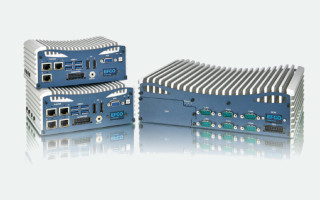EFCO's Industrial Computers Lend Intelligent Embedded Vision for Pandemic Prevention Applications
April 10, 2020
Press Release

Embedded vision and artificial intelligence are playing a key role in helping these companies to adapt their production lines to meet this latest need.
As COVID-19 shakes up business around the globe, companies from a variety of non-healthcare industries have stepped up to help speed production of greatly needed medical equipment by adapting their manufacturing lines for items such as ventilators and air purifiers. Embedded vision and artificial intelligence are playing a key role in helping these companies to adapt their production lines to meet this latest need. In addition, embedded vision is also providing the basis for new healthcare technologies aimed at proactive epidemic prevention.
Embedded vision is increasingly being integrated into technology of all kinds.
Because an image processing system puts the PC and operating system under extreme performance loads, specialized and task-optimized image processing machines have become a necessity. EFCO developed its embedded vision systems, Eagle Eyes, to address this growing demand.
Eagle Eyes Improves Smart-Factory Production of Healthcare Face Masks
Image processing in an industrial setting makes it possible to automatically check individual parts and steps in the manufacturing of products. Eagle Eyes was designed specifically for use in such smart-factory applications, and has been ideally suited to help production lines quickly switch and adapt to the manufacture of new items such as the recent surge in the worldwide demand for healthcare face masks. Eagle Eyes incorporates features such as power-over-ethernet (PoE), preventative system monitoring and artificial intelligence to recognize imminent failures before they happen. Based on propriety artificial intelligence algorithms, it provides all-systems monitoring and predictive maintenance triggers to prevent downtime.
Proactive Pandemic Prevention Using Specialized Image Processing Machines
Embedded vision is also key to the design of new healthcare tools and technologies currently being developed for a proactive approach to helping to prevent an epidemic. Smart temperature screening, which is now being deployed in Taiwan, is a new application and one way to identify people that may be ill. The system helps to reduce direct contact between healthy people and those that may be contagious, thus achieving the effect of intelligent epidemic prevention and helping to stunt the spread of new disease. By allowing body temperature to be remotely monitored through a dual-lens thermal sensor, and identifying people in a crowd who are running a fever, this diagnostic can be used to alert people who might not even know they are sick, to take precautions and get help from their healthcare provider.
Critical image processing applications such as these require extreme performance requirements and accuracy. EFCO’s task-optimated logic computers ensure reliability. The basic system features of the Eagle Eye are specifically designed to meet the market needs of machine vision in full. In particular, they focus on the areas of factory automation, machine vision and transportation/logistics. The Eagle Eyes systems are equipped with state-of-the-art Intel Skylake / Kabylake i3/i5/i7 CPUs and offer up to six Gigabit Ethernet interfaces for sophisticated image processing tasks, four of which are equipped with PoE PSE to power IP cameras. The two remaining Gigabit Ethernet interfaces can be used to integrate a real-time fieldbus such as EtherCAT as well as a classic TCP/IP network. Another four USB 3.0 interfaces are used to connect additional peripherals such as USB camera systems. For integration into the machine environment, eight optically isolated inputs and eight also optically isolated outputs are available. The six classic serial interfaces, which contain two RS-485 interfaces, can be used to establish connections to older system components that are still in use.
As we look to the future and what we’ve learned from the need to quickly adapt in the time of a crisis such as COVID-19, task-optimized image processing combined with artificial intelligence offers a number of advantages. From production line efficiency to new product features, the technology is available and being used in new and creative ways to respond to market demands.




